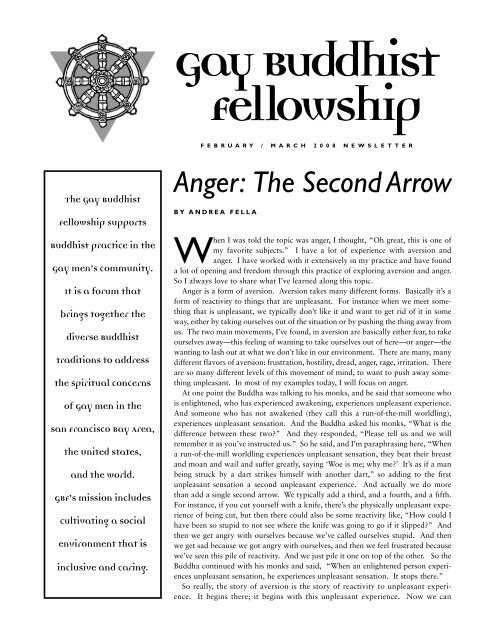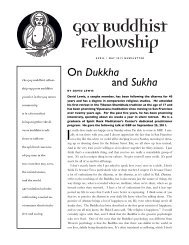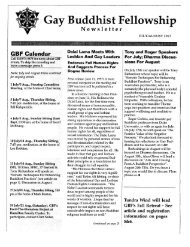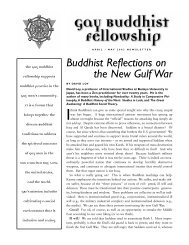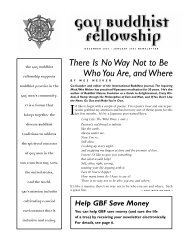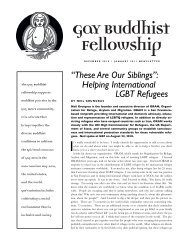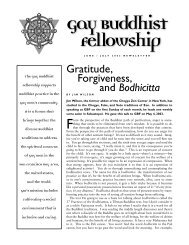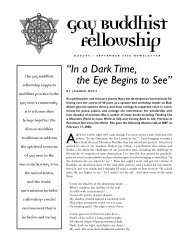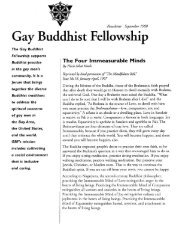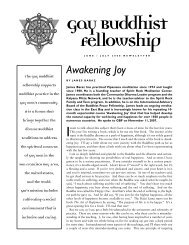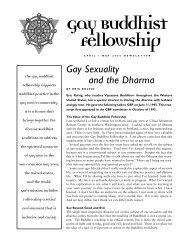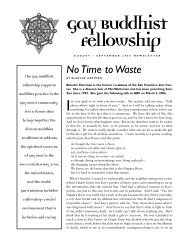2008.02 Andrea Fella (Anger-The Second Arrow).pdf - Gay Buddhist ...
2008.02 Andrea Fella (Anger-The Second Arrow).pdf - Gay Buddhist ...
2008.02 Andrea Fella (Anger-The Second Arrow).pdf - Gay Buddhist ...
You also want an ePaper? Increase the reach of your titles
YUMPU automatically turns print PDFs into web optimized ePapers that Google loves.
<strong>Gay</strong> <strong>Buddhist</strong><br />
Fellowship<br />
F E B R U A R Y / M A R C H 2 0 0 8<br />
N E W S L E T T E R<br />
<strong>The</strong> <strong>Gay</strong> <strong>Buddhist</strong><br />
Fellowship supports<br />
<strong>Buddhist</strong> practice in the<br />
<strong>Gay</strong> men’s community.<br />
It is a forum that<br />
brings together the<br />
diverse <strong>Buddhist</strong><br />
traditions to address<br />
the spiritual concerns<br />
of <strong>Gay</strong> men in the<br />
San Francisco Bay Area,<br />
the United States,<br />
and the world.<br />
GBF’s mission includes<br />
cultivating a social<br />
environment that is<br />
inclusive and caring.<br />
<strong>Anger</strong>: <strong>The</strong> <strong>Second</strong> <strong>Arrow</strong><br />
BY ANDREA FELLA<br />
When I was told the topic was anger, I thought, “Oh great, this is one of<br />
my favorite subjects.” I have a lot of experience with aversion and<br />
anger. I have worked with it extensively in my practice and have found<br />
a lot of opening and freedom through this practice of exploring aversion and anger.<br />
So I always love to share what I’ve learned along this topic.<br />
<strong>Anger</strong> is a form of aversion. Aversion takes many different forms. Basically it’s a<br />
form of reactivity to things that are unpleasant. For instance when we meet something<br />
that is unpleasant, we typically don’t like it and want to get rid of it in some<br />
way, either by taking ourselves out of the situation or by pushing the thing away from<br />
us. <strong>The</strong> two main movements, I’ve found, in aversion are basically either fear, to take<br />
ourselves away—this feeling of wanting to take ourselves out of here—or anger—the<br />
wanting to lash out at what we don’t like in our environment. <strong>The</strong>re are many, many<br />
different flavors of aversion: frustration, hostility, dread, anger, rage, irritation. <strong>The</strong>re<br />
are so many different levels of this movement of mind, to want to push away something<br />
unpleasant. In most of my examples today, I will focus on anger.<br />
At one point the Buddha was talking to his monks, and he said that someone who<br />
is enlightened, who has experienced awakening, experiences unpleasant experience.<br />
And someone who has not awakened (they call this a run-of-the-mill worldling),<br />
experiences unpleasant sensation. And the Buddha asked his monks, “What is the<br />
difference between these two?” And they responded, “Please tell us and we will<br />
remember it as you’ve instructed us.” So he said, and I’m paraphrasing here, “When<br />
a run-of-the-mill worldling experiences unpleasant sensation, they beat their breast<br />
and moan and wail and suffer greatly, saying ‘Woe is me; why me?’ It’s as if a man<br />
being struck by a dart strikes himself with another dart,” so adding to the first<br />
unpleasant sensation a second unpleasant experience. And actually we do more<br />
than add a single second arrow. We typically add a third, and a fourth, and a fifth.<br />
For instance, if you cut yourself with a knife, there’s the physically unpleasant experience<br />
of being cut, but then there could also be some reactivity like, “How could I<br />
have been so stupid to not see where the knife was going to go if it slipped?” And<br />
then we get angry with ourselves because we’ve called ourselves stupid. And then<br />
we get sad because we got angry with ourselves, and then we feel frustrated because<br />
we’ve seen this pile of reactivity. And we just pile it one on top of the other. So the<br />
Buddha continued with his monks and said, “When an enlightened person experiences<br />
unpleasant sensation, he experiences unpleasant sensation. It stops there.”<br />
So really, the story of aversion is the story of reactivity to unpleasant experience.<br />
It begins there; it begins with this unpleasant experience. Now we can
actually witness this in our practice. We can see that our<br />
reactivity is born out of unpleasantness and mushrooms in<br />
this way. We can begin to see where our reactivity begins.<br />
But often in our practice, we don’t see that. What we see<br />
instead is a full-blown rage. We wake up; we become aware<br />
that we are enraged. And we need to learn how to practice<br />
with that as well.<br />
I think that aversion is a very natural experience. It is a<br />
form of reactivity, but it’s a very natural thing. So I want to<br />
just encourage you to think of it as a normal thing in the<br />
mind. It’s not really something to think of as a bad thing necessarily.<br />
It serves a function for us. And I think it actually has<br />
its roots in biological experience. So even an amoeba, for<br />
instance, in a noxious environment will pull away from the<br />
noxious aspect of it. And an amoeba will move towards food.<br />
<strong>The</strong>re’s a kind of natural response to move away from<br />
unpleasant and toward pleasant. But in our brains we seem<br />
to have taken this to a kind of extreme and react to things that<br />
are not necessary to react to. But it can be born out of some<br />
very deep experience, from childhood for instance. <strong>The</strong> kind<br />
of reactivity we learn in childhood—that we need to protect<br />
ourselves in some way—was functional at that point in our<br />
lives. <strong>The</strong>n, as we get to be adults, that pattern has become<br />
habituated. It’s become a groove in our minds, a way that<br />
we’ve learned to respond to a specific situation. And yet it is<br />
no longer so necessary. This is the kind of reactivity we can<br />
learn to unwind through our meditation practice.<br />
I think that aversion, and anger particularly, can serve as a<br />
signal for us. It’s something that needs to be paid attention to.<br />
What I’m suggesting by saying “anger needs to be paid<br />
attention to” is that instead of focusing outward at what we’re<br />
angry at, we should turn the attention back on the experience<br />
of anger itself. What does it feel like to be a human being who<br />
is angry? That shift is a huge shift for us. It is a movement of<br />
mindfulness, a movement of our practice: to turn our attention<br />
toward what the actual experience of anger is.<br />
When I did this early in my practice, anger was actually the<br />
doorway through which I entered practice in the first place. It<br />
was an out-of-control experience for me. I knew I needed to<br />
do something. I was basically non-functional at times because<br />
the anger got so strong. I could see that the anger was overwhelming,<br />
and I was pretty focused on the person that I was<br />
angry at. I could see, actually, as I began to do this mindfulness<br />
of the anger, that there was a belief that somehow the<br />
anger I was experiencing would harm the person that I was<br />
angry with, that it would teach him a lesson. It would somehow<br />
get out there and do something to him. Now, my circumstances<br />
at the time were that I was in the Peace Corps, on<br />
a little tiny island in the South Pacific, about 7,000 miles away<br />
from California, where the person I was angry with was living.<br />
So it became kind of clear that that anger was not going<br />
travel 7,000 miles. But it was eating me up.<br />
<strong>The</strong>re’s a story the Buddha tells about anger. He says anger<br />
is like picking up a hot coal to throw at somebody and you have<br />
the belief that you’re going to hurt that person, but you burn<br />
yourself in the process. And I was experiencing that in spades.<br />
So how do we turn our attention to the anger? How do<br />
we practice with aversion? One of the most effective ways<br />
<strong>The</strong> kind of reactivity we learn in childhood—that we need to<br />
protect ourselves in some way—was functional at that point in<br />
our lives. <strong>The</strong>n, as we get to be adults, that pattern has become<br />
habituated. It’s become a groove in our minds, a way that<br />
we’ve learned to respond to a specific situation. And yet it is<br />
no longer so necessary. This is the kind of reactivity we can<br />
learn to unwind through our meditation practice.<br />
Something that’s going on that needs to be attended to. But<br />
our typical way of attending to things that we get angry about,<br />
or are aversive to, is to focus on the thing in the world. When<br />
we experience anger, we typically focus on the thing we’re<br />
angry at, the person we’re angry at. And when I speak of<br />
anger as a signal that something needs to be attended to, I’m<br />
not speaking about paying attention to something “out there”<br />
that we need to fix. Because that’s typically how we respond—<br />
that we need to fix something—either by taking ourselves out<br />
of the situation, or by doing something to our environment to<br />
try to change it, or trying to change another person.<br />
that I’ve found in working with aversion and anger is to turn<br />
the attention to the physical experience in the body, what’s<br />
going on in the body. <strong>The</strong>re are so many different experiences<br />
we can have when we’re angry. <strong>The</strong> body can get tight,<br />
hot, churning. <strong>The</strong>re can be feeling of tension, of pressure in<br />
the body, maybe a clenching in the jaw. <strong>The</strong>re are a lot of<br />
physical experiences we can have when we’re angry. <strong>The</strong><br />
point, or the reason it’s skillful to turn our attention to the<br />
body when we’re angry, is that so much of the anger is fed by<br />
the thoughts around the anger. “He did this. She did that.<br />
<strong>The</strong>y shouldn’t have done this. Why did they do that? I’m<br />
2 GBF F E B R U A R Y / M A R C H 2 0 0 8 N E W S L E T T E R
etreat. I got to pay attention to the thought that would trigger<br />
the manifestation of anger and see the whole thing come<br />
into being. And one time I saw the thought, and then in the<br />
next moment I saw just the beginnings of this movement<br />
toward a kind of a feeling of self-righteousness. And that felt<br />
warm and full; it was very pleasant. And very quickly it<br />
moved into hot and pressured and very unpleasant. But I<br />
thought, “Oh my gosh, that was like the hook.” That split<br />
I thought if I started paying attention to anger, it would get<br />
worse; it would get stronger. But that’s not the case. If you<br />
pay attention to the thoughts around the anger and think<br />
about the anger, it does get worse. But simply paying attention<br />
to the physical experience, in a non-judgmental, nonreactive<br />
way, actually allows the experience of anger to flow<br />
through us. It allows that to live its life. All the emotions<br />
have a life. <strong>The</strong>y have an arising and a passing, like a wave.<br />
going to do this to them because they did that. I could have<br />
done it better.” All of those thoughts actually feed the anger<br />
and make it stronger.<br />
Turning our attention to the body does a couple of things.<br />
First, it keeps us in the present moment. It keeps us experiencing<br />
what’s happening here and now. It’s not repressing<br />
what we’re experiencing. It’s not turning away from what<br />
we’re experiencing. It’s not saying, “I’m not going to experience<br />
this anger.” It’s allowing you to be there, experiencing it,<br />
but it’s not engaging in the content or the story around the<br />
anger. It doesn’t feed the anger to pay attention in this way.<br />
Mindfulness is a beautiful tool for us. It has this capacity,<br />
or this quality, that when we pay attention to unskillful states<br />
of mind (anger, hostility, frustration), it creates the conditions<br />
for it to appear less frequently in our lives. Now this kind of<br />
seems a little counterintuitive. At least it did to me when I<br />
first started paying attention. I thought if I started paying<br />
attention to anger, it would get worse; it would get stronger.<br />
But that’s not the case. If you pay attention to the thoughts<br />
around the anger and think about the anger, it does get<br />
worse. But simply paying attention to the physical experience,<br />
in a non-judgmental, non-reactive way, actually allows<br />
the experience of anger to flow through us. It allows that to<br />
live its life. All the emotions have a life. <strong>The</strong>y have an arising<br />
and a passing, like a wave. And if we bring a mindful<br />
attention to our emotions it allows them to live their life in a<br />
natural way, to come into being, to crest, and then to flow<br />
out. This mindful awareness to the body allows the emotions<br />
to manifest in this way in our experience, to feel the full<br />
fruition of it and then to flow out.<br />
In this early experience of anger that I described when I was<br />
first paying attention to the anger, it was pretty clear that the<br />
bodily experience of anger was really unpleasant. Physically<br />
unpleasant. <strong>The</strong>re seemed to be this movement, this desire to<br />
be angry. I could see that kind of pull or movement to be<br />
angry. And I thought, “Why am I doing that when it’s such<br />
an unpleasant experience?” On a two-week retreat, something<br />
happened fairly early into the retreat that made me<br />
angry. It kept coming back over and over again so I got to pay<br />
attention to anger in a very detailed, specific way on that<br />
second of pleasant sensation might be part of the reason why<br />
we go there. <strong>The</strong>re’s that feeling of being so alive and present<br />
and in power, imbued with the sense of being, in the split second<br />
before it turned into full-blown anger. So that was very<br />
interesting to me, this observation of anger.<br />
Because of the physical experience of anger, and also the<br />
mental experience of anger (they’re both unpleasant), it can be<br />
difficult to turn our attention sometimes. It can be a challenge<br />
to stay in that space of unpleasant experience. But when we<br />
start to do this in a non-reactive way, when we bring our<br />
attention to anger in a non-reactive way, we do begin to see<br />
this quality that the mindfulness has to kind of lubricate the<br />
anger and to allow it to flow in the way we can see causes us<br />
less suffering. So we start to see that bringing mindful awareness<br />
to our anger actually is less suffering than it is when we<br />
are caught up in our anger.<br />
It’s really helpful paying attention to anger and to aversion.<br />
And as you pay attention to anger you’ll probably start to see<br />
the subtler forms of it: the pushing away, the resistance, the<br />
not liking the experience, the aversive side of it. It’s really<br />
helpful to simply recognize it in our experience, just to recognize<br />
that aversion is happening, anger is happening. That<br />
simple recognition is very, very powerful.<br />
What I’m talking about here can be practiced on the cushion,<br />
but also in our daily lives. In fact, the majority of my<br />
work with anger has been in my daily life, and not so much<br />
on the cushion. In fact when I first started the meditation<br />
practice I was dealing with so much anger, I realized the meditation<br />
was a place where I could take refuge from the anger.<br />
I could take a break from anger sitting on the cushion. So I<br />
didn’t try to explore it too much in the meditation itself, but<br />
in my daily life it was running rampant. So I really dedicated<br />
GBF F E B R U A R Y / M A R C H 2 0 0 8 N E W S L E T T E R 3
my mindfulness practice in daily life to observing anger. This<br />
can be a major work in our daily lives. And this recognition<br />
tool, recognizing that “this is anger,” is very powerful.<br />
I’ll tell you a story of how this functioned for me in those<br />
early months of my practice. I didn’t have much training at<br />
that point. I was in the South Pacific, and there were a couple<br />
of books on meditation, but most of them were not very<br />
accessible. But a friend sent me a book called Everyday Zen<br />
by Joko Beck, and in that book she talked about picking some<br />
have the skills to know what it meant to bring the attention<br />
inward. All I was doing was recognizing, simply recognizing.<br />
And over the course of several months of this, I began<br />
waking up even earlier so that it was more of an irritation<br />
than even anger.<br />
And then one day, I was in my kitchen and I was cutting an<br />
apple, and I saw a thought go through my mind about the person<br />
I was angry with. We were at a fruit stand at the Sacramento<br />
River delta, and I could see the connection with what I<br />
And in that moment of seeing, the mind realized it had a choice:<br />
go down that path where I’m going to experience suffering<br />
through the anger, or let it go. My mind said,“I’m not going to<br />
do this. I’m going to let it go.” It’s kind of like what happens<br />
when the body touches a hot pot on the stove and releases it<br />
even before you’ve actually felt the heat. <strong>The</strong> mind let it go<br />
because it knew if it went that way, it would suffer.<br />
projects to be mindful about in your daily life. I wasn’t particularly<br />
inclined toward sitting meditation practice at this<br />
point, but I liked this idea of bringing mindfulness practice<br />
into my daily life, and in particular to the anger because that<br />
was out of control. So I chose the anger as a project, something<br />
to bring my mindfulness to, as Joko Beck had suggested.<br />
I said to myself, whenever I get angry I will pay attention<br />
to it. And what I discovered as I did this was that initially I<br />
wouldn’t remember to pay attention. And my anger at that<br />
point was such that it didn’t tend to just go away; it tended to<br />
get bigger and bigger and bigger.<br />
At some point I would remember that I’d told myself that<br />
I’d resolved to pay attention to this anger and I would be in a<br />
full-blown rage. About all I could do at that point—and<br />
again I had very little training, but I knew that I was angry—<br />
was to recognize it. And just that recognition, “Yup, I’m<br />
angry. Boy, am I angry,” was about all I could do. And I’d<br />
be thinking, “So what I do with this? What does it mean to<br />
be mindful of this?” And after some period of time of just<br />
going, “Yup, angry again,” I thought I guess I just go back to<br />
work. I was often sitting at my desk when I would observe<br />
my anger, at the computer.<br />
Over the course of months of doing this, I began to see<br />
that this resolve to wake up for the anger began to wake me<br />
up earlier in the process of anger so that instead of being a<br />
full-blown rage at the time that I became aware that I was<br />
supposed to pay attention, it would be more of the “normal”<br />
anger. That was a little bit easier to tolerate than the<br />
full-blown rage. I could see that the rage was much more<br />
challenging. With the normal anger, it was much easier to<br />
say, “Yup, I can sit with this for a few minutes.” I didn’t<br />
was doing (cutting the apple) and the thought. I could also see,<br />
in that moment, this momentum of the mind to jump on that<br />
thought and think more thoughts in order to get angry. I wasn’t<br />
angry in that moment of the thought appearing. I wasn’t<br />
angry yet, but I could feel this freight train of desire to get angry.<br />
I’d spent a lot of time in the previous months paying attention<br />
to rage, to anger, and seeing how unpleasant it was. And<br />
in that moment of seeing—there’s the thought, the momentum,<br />
or the intention or inclination toward anger—the mind (and I<br />
didn’t do any of this; this wasn’t a conscious thing; this is really<br />
the process unfolding in a natural way) realized it had a<br />
choice: go down that path where I’m going to experience suffering<br />
through the anger, or let it go. My mind said, “I’m not<br />
going to do this. I’m going to let it go.” It’s kind of like what<br />
happens when the body touches a hot pot on the stove and<br />
releases it even before you’ve actually felt the heat. <strong>The</strong> mind<br />
let it go because it knew if it went that way, it would suffer.<br />
And in the next moment I stood there and waited to get<br />
angry, because I had seen all of this. I had seen, “Oh, I have<br />
a choice; I don’t have to go down that road,” but I didn’t<br />
believe it. I thought there was an intricate, linked connection<br />
between the thought of this person and the anger and<br />
that there would be no way that that thought could arise<br />
without the anger arising. So I stood there waiting to get<br />
angry. But I did not get angry. I was completely blown<br />
away by the power of that mindfulness to insert itself into<br />
the process, this habit of mind, of seeing my mind wanting<br />
to get angry. I saw how powerful the mindfulness was<br />
around that. That was the moment that I got hooked on<br />
this practice. That was it. I had really seen the power of<br />
mindfulness through this daily observation of anger.<br />
4 GBF F E B R U A R Y / M A R C H 2 0 0 8 N E W S L E T T E R
Now, I’m not saying that I never got angry again. In fact I<br />
worked with anger with this person for years after that point.<br />
But I could see that this was the route. This was the way out<br />
of the anger. It had the capacity to take me beyond the anger.<br />
One of my teachers, Carol Wilson, says that when we’re<br />
experiencing aversion, and likewise anger, there’s something<br />
unpleasant in our experience. But often when we’re<br />
experiencing aversion we’re not really aware of what the<br />
unpleasant thing is that we are reacting to. When we’re<br />
angry, we’re usually aware of what we’re angry about,<br />
although sometimes I’ve seen myself, particularly on<br />
retreat, get into these aversive states of the mind. I remember<br />
one time doing walking meditation and seeing somebody’s<br />
shoes sitting at the end of the walking path, and<br />
there was aversion to the shoes. But I could see that the<br />
mind was colored with aversion, that we get into these<br />
states where the mind is colored with aversion. For myself<br />
I’ve seen this happen when I get really hungry; then everything<br />
is aversive. And finally when I began to see that, I<br />
realized I could just experience it, the physically unpleasant<br />
sensations. And for some reason, I used to become very<br />
reactive to those physical, body experiences and now I can<br />
pretty much just be with that experience. I just know,<br />
“Yup, this is that state.” It no longer tends to go into lashing<br />
out at others. It stays with the unpleasantness, and I<br />
don’t end up reacting out toward others.<br />
So, looking at our experience, what is the actual root, the<br />
source, of the aversion? Is there something going on? Sometimes<br />
when we are working with strong habits of mind, and<br />
this is true for any kind of strong habit of mind (anger it was<br />
for me, self-hatred it was for me), we see that there tend to<br />
be these ruts in our mind. And when we get anywhere near<br />
these ruts of mind, it becomes almost impossible to avoid<br />
strong enough to meet the anger. And I found that it was<br />
helpful to turn my attention to something neutral in my experience.<br />
What I’d do is notice the anger, I’d recognize it, and it<br />
was almost like I’d speak to it for a moment. I’d say, “Yup, I<br />
see you anger. And I also see that right now is not a good time<br />
to pay attention to you directly because I know I’ll get caught.<br />
So I’m going to pay attention to my feet on the ground.” I<br />
also kind of made a bargain with it. I’d say, “I’ll pay attention<br />
to you as my mindfulness grows stronger.” This was a<br />
way to put the anger aside without aversion. If we do this<br />
“taking our attention away to something neutral” in a way<br />
that’s aversive, then that will just feed the aversive habit. But<br />
if it’s a simple putting aside—“not now”—and going to a neutral<br />
sensation, that can be a very powerful practice over years.<br />
And I did this for years. Again, I noticed I’d break into the<br />
cycle of anger earlier and earlier. In this case I began noticing<br />
that the bouts of anger were getting further apart. I’d notice<br />
that I was angry, tell myself, “Not now,” pay attention to<br />
something neutral in my experience, and just stay there for a<br />
while. <strong>The</strong> bouts of anger became further and further apart.<br />
And then one day I remember walking to my house and I<br />
realized that I hadn’t been angry at this person in a very long<br />
time. And I thought, “I wonder where it is.” And even having<br />
this person in mind at that moment, I couldn’t generate<br />
the anger. I thought, “Is it gone?” I couldn’t find it at all.<br />
And it has never come back since that recognition. In fact,<br />
what has replaced it is a sense of kindness and care for that<br />
person. Just that recognition, “Yup, I’m angry,” putting it<br />
aside, coming to something neutral—that practice itself was<br />
extremely powerful.<br />
I’m not saying I don’t get angry at all. But that particular<br />
anger at that particular person is gone from my life. Completely<br />
eradicated. I can’t even summon it up anymore. I can<br />
Sometimes when we are working with strong habits of mind,<br />
and this is true for any kind of strong habit of mind, we see that<br />
there tend to be these ruts in our mind. And when we get anywhere<br />
near these ruts of mind, it becomes almost impossible<br />
to avoid dropping right into them.<br />
dropping right into them. At times with very powerful states<br />
or habits like that, it can be challenging to bring mindfulness<br />
to them because the state or habit is stronger than the ability<br />
to be mindful of it.<br />
I found this for myself around anger, the same anger I<br />
talked about earlier; it continued on for years. And I began<br />
to get the tools and techniques for working with it, with<br />
mindfulness, paying attention to the body. But I discovered<br />
that as often as I’d do this—bring the mindfulness into it—at<br />
some point I’d lose the mindfulness and end up in the anger<br />
again. And so I began to see that the mindfulness wasn’t quite<br />
remember that I was angry, but I cannot summon it up. So this<br />
practice of bringing mindfulness to our anger can be really<br />
powerful. Not only can it make our lives easier, but it’s also a<br />
doorway into insight into impermanence, into suffering, into<br />
the emptiness of experience. I’ve found for myself that paying<br />
attention to these difficult states of mind has been a huge doorway<br />
toward those deeper insights. It’s not a lesser practice to<br />
pay attention to these things. It doesn’t really matter what we<br />
pay attention to with mindfulness. Anything we bring our<br />
attention to is the right thing to be paying attention to, and<br />
that mindfulness will lead to very deep, liberating insight. ■<br />
GBF F E B R U A R Y / M A R C H 2 0 0 8 N E W S L E T T E R 5
G B F<br />
STEERING COMMITTEE<br />
Ray Dyer<br />
Clint Seiter<br />
Marvin Snow<br />
Jim Stewart<br />
TREASURER<br />
Teng-How Bae<br />
NEWSLETTER<br />
Editor<br />
Michael Langdon<br />
Design / Layout<br />
Michael Gabel<br />
Transcribers<br />
Ray Dyer<br />
Dan Rosnik<br />
Mailing List<br />
Todd Pope<br />
Robin Levitt<br />
Newsletter Mailing<br />
Jack Busby<br />
Your Thrift Store<br />
Donations Earn Money for GBF<br />
GBF members can donate their quality cast-offs to the Community Thrift Store<br />
(CTS) and GBF will receive a quarterly check based on the volume of items sold.<br />
This is a great way to support our Sangha, and the community. So far this year<br />
we have received over $800 through members’ generosity. Bring your extra clothing<br />
and other items to CTS at 623 Valencia St between 10am and 5pm, any day<br />
of the week. <strong>The</strong> donation door is around the corner on Sycamore Alley (parallel<br />
to and between 17th and 18th) between Valencia and Mission. Tell the worker<br />
you are donating to GBF. Our ID number is 40. Information: (415) 861-4910.<br />
MAIL<br />
Bill Chiles<br />
LARKIN STREET<br />
YOUTH CENTER<br />
Volunteer Coordinator<br />
Clint Seiter<br />
Bill Weber<br />
PRISON OUTREACH<br />
Coordinator<br />
Baruch Golden<br />
WEBSITE<br />
Joe Kukulka<br />
YAHOO GROUP MODERATOR<br />
George Hubbard<br />
SUNDAY SITTINGS<br />
Program Committee<br />
Dean Bellerby<br />
Howard DePorte<br />
Baruch Golden<br />
Jerry Jones<br />
Gary Pedler<br />
Jim Stewart<br />
Speaker Coordinator<br />
Baruch Golden<br />
Facilitator Coordinator<br />
Ray Dyer<br />
Facilitators<br />
Dean Bellerby<br />
Peter Camarda<br />
Ray Dyer<br />
Joe Goode<br />
Marvin Snow<br />
Host Coordinator<br />
Kei Matsuda<br />
Hosts<br />
Cass Brayton<br />
Jay Corbett<br />
Peter Dell<br />
Richard Hedden<br />
Mark Hoffheimer<br />
Dave Limcaco<br />
Kei Matsuda<br />
Todd Pope<br />
Oscar Saginoya<br />
Paul Shepard<br />
Marvin Snow<br />
Harv Whitten<br />
Larry Wisch<br />
Nobu Yamaji<br />
Sound / Recordings<br />
George Hubbard<br />
How to Reach Us<br />
www.gaybuddhist.org<br />
For general questions about GBF write to:<br />
inquiry@gaybuddhist.org<br />
To reach our Program Committee with suggestions for speakers and comments, go<br />
to:<br />
www.gaybuddhist.org/programs<br />
Mail correspondence:<br />
GBF<br />
PMB 456<br />
2215—R MARKET STREET<br />
SAN FRANCISCO CA 94114<br />
For address changes or to subscribe or unsubscribe to the newsletter send email<br />
to:<br />
mailinglist@gaybuddhist.org<br />
GBF Newsletter. Send submissions to:<br />
editor@gaybuddhist.org<br />
GBF Yahoo Discussion Group<br />
<strong>The</strong>re is now a GBF discussion group for the general membership (and others) on<br />
Yahoo. Join the discussion at:<br />
www.groups.yahoo.com/group/gaybuddhistfellowship<br />
6 GBF F E B R U A R Y / M A R C H 2 0 0 8 N E W S L E T T E R
Calendar<br />
Sunday Sittings<br />
10:30 am to 12 noon<br />
Every Sunday at 10:30am we meditate together for 30 minutes,<br />
followed by a talk or discussion till 12 noon. Everyone is then<br />
welcome to stay and socialize over refreshments till approximately<br />
12:30, after which those who are interested usually go<br />
somewhere local for lunch. Our sittings are held at the San<br />
Francisco <strong>Buddhist</strong> Center, 37 Bartlett Street. (Look for the red<br />
door near 21st St between Mission and Valencia Streets).<br />
MUNI: 14 Mission or 49 Van Ness-Mission, alight at 21st St,<br />
walk 1/2 block.<br />
BART: 24th and Mission, walk 31/2 blocks. PARKING: on street<br />
(meters free on Sundays) or in adjacent New Mission Bartlett<br />
Garage. <strong>The</strong> Center is handicapped accessible.<br />
Sunday Speakers<br />
February 3<br />
Discussion on <strong>Gay</strong> Sangha<br />
Clint Seiter and Carl Wolf, long-time GBF sangha members, will<br />
share their thinking about the meaning and role of gay sangha<br />
in our lives. <strong>The</strong>re will be an opportunity for group discussion<br />
during the talk.<br />
February 10<br />
Lee Lipp<br />
Lee Lipp, Ph.D., has a therapy practice in San Francisco and<br />
supervises at Haight Ashbury Psychological Services. She has<br />
been a member of Thich Nhat Hahn’s Order of Interbeing,<br />
practicing Zen and Vipassana, since 1990. She is the Diversity/Outreach<br />
Coordinator at the San Francisco Zen Center. She<br />
teaches “Transforming Depression” classes in venues that<br />
include Spirit Rock Meditation Center, Insight Meditation Society,<br />
Zen Hospice Project, Tassajara Mountain Center, and the<br />
San Francisco Zen Center. She is presently teaching for the San<br />
Francisco Mental Health Association and the San Francisco<br />
Department of Mental Health.<br />
February 17<br />
Joanna Macy<br />
Eco-philosopher and visionary Joanna Macy has developed an<br />
international following over the course of 40 years as a speaker<br />
and workshop leader on Buddhism, general systems theory,<br />
and deep ecology. A respected voice in movements for peace,<br />
justice, and ecology, she interweaves her scholarship with four<br />
decades of activism. She is author of many books including<br />
Thinking Like a Mountain,World as Lover,World as Self and Coming<br />
Back to Life: Practices to Reconnect Our Lives, Our World.<br />
http://www.joannamacy.net/<br />
February 24<br />
Open Discussion<br />
March 2<br />
Susan Moon<br />
Susan Moon is a writer, teacher and until recently the editor of<br />
Turning Wheel magazine. She is the author of <strong>The</strong> Life and Letters<br />
of Tofu Roshi, a humor book about an imaginary Zen master, and<br />
editor of Not Turning Away: <strong>The</strong> Practice of Engaged Buddhism. Her<br />
short stories and personal essays have been published widely.<br />
She is the mother of two grown sons. Sue has been a Zen student<br />
since 1976, practicing in the lineage of Suzuki Roshi at<br />
Berkeley Zen Center,Tassajara Zen Mountain Monastery, Green<br />
Gulch Farm, and now with Zoketsu Norman Fischer’s Everyday<br />
Zen sangha. She has received “lay entrustment,” a lay version of<br />
dharma transmission, from Norman Fischer.<br />
March 9<br />
Lin Maslow<br />
Gensha Lin Maslow is a zen priest in the tradition of Shunryu<br />
Suzuki, ordained by Chikudo Lewis Richmond in 2006. Deciding<br />
he just wasn’t a theist at age 17, he abandoned his Jewish<br />
religion of origin, searching for a more direct and enriching<br />
spiritual practice. He began practicing Zen Buddhism at Tassajara<br />
Zen Mountain Center in 1980. <strong>The</strong>re were several<br />
years of deep involvement with the Radical Faeries in the 80s.<br />
He practices with the Vimala Sangha in Mill Valley (for more<br />
information, see vimalasangha.org), where he aspires to attain<br />
nothing (except a partner, when the time is right, like now).<br />
He is a hospice nurse.<br />
March 16<br />
Jennifer Berazon<br />
Jennifer Berazon is a singer/songwriter, teacher and activist. She<br />
has made eight albums. Beginning in 1995 she started her journey<br />
into meditative trance music and wordless chanting and<br />
singing, which she will share with us. In her musical career she<br />
has explored music as a spiritual practice from cross-cultural,<br />
traditional, <strong>Buddhist</strong> and contemporary perspectives. She<br />
teaches at the California Institute of Integral Studies, in the<br />
department of Philosophy and Religion. She has been involved<br />
in <strong>Buddhist</strong> practice for many years. For more information, see<br />
http://www.edgeofwonder.com.<br />
March 23<br />
Evan Kavanagh<br />
Evan Kavanagh has been practicing Vipassana meditation<br />
since 1995. He has led meditation groups in the 12-step tradition<br />
and is a graduate of the Spirit Rock Dedicated Practitioners<br />
Program. Evan has served as the Executive Director<br />
of Spirit Rock Meditation Center since 2000. His professional<br />
work has included serving as the executive director of the<br />
Western Alliance of Arts Administrators Foundation. Evan<br />
and his husband Andrew live in San Francisco, where they<br />
were married in 2004.<br />
March 30<br />
Open Discussion<br />
GBF FEBRUARY / MARCH 2 0 0 8 N E W S L E T T E R 7
GBF NEWSLETTER<br />
PMB 456<br />
2215-R MARKET STREET<br />
SAN FRANCISCO CA 94114<br />
ADDRESS SERVICE REQUESTED<br />
By the power and truth of this practice, may all beings have<br />
happiness and the causes of happiness, may all be free from sorrow<br />
and the causes of sorrow, may all never be separated from the sacred<br />
happiness which is without sorrow, and may all live in equanimity,<br />
without too much attachment or too much aversion, and live<br />
believing in the equality of all that lives.<br />
—GBF Dedication of Merit


